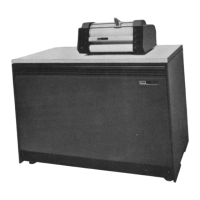just
the
number
of positions of
the
card
that
you
want
to
bring
into
the
program.
In
this example,
if
the
specification for K
had
been
14,
the
proc-
essor
would
assume
that
the
value
for K was located
in
columns 1 to 4,
that
the
value for M was
punched
beginning
with
column 5,
and
that
the
value of A was
punched
beginning
with
column 12,
etc:;thus
all
subsequent
fields
would
be
read
incorrectly.
3.
The
floating
point
variable A is
read
in
according to
FORMAT
F7.3. This
format tells
the
processor
that
the
value is to
be
a floating
point
number,
that
the
field in
the
card
contains 7 columns,
and
that
there
will
be
3 digits
to
the
right
of
the
decimal place.
The
object program will consider A to
have
the
value of 1234.567,
then
"place"
the
decimal
point
to
the
left of
the
high-order (leftmost) digit,
and
set
the
exponent as 04 for this value to
account
for
the
number
of positions
that
the
decimal
point
is shifted.
4.
The"floating
point
variable B is
read
in according to
FORMAT
F12.0. This
format tells
the
processor
that
the
value is a floating
point
number,
and
that
the
field in
the
card
contains 12 columns. Because
the
decimal
point
is
punched
in
the
card
in its
proper
place, a specification for d is
not
re-
quired,
and
if
specified will
be
ignored
by
the
object program.
The
maxi-
mum
size of a mantissa
in
a floating
point
number
is 8 positions, so
the
low-
order
positions of
the
quantity
are
truncated.
When
the
value is stored,
the
decimal
point
is
adjusted
six
places
and
the
exponent is set to 06.
5. Columns 33
through
50 contain
blank
columns
and
punched
data
that
are
not
required
in
the
program.
These
columns
are
read
into
the
record
by
giving
the
processor
the
specification 18X.
Even
though
this
data
may
not
be
used
by
the
program,
it
will
be
punched
or
printed
in
an
output
record
if
the
same
FORMAT
statement
is
used
for
both
input
and
output.
The
maximum
number
of
columns
that
can
be
read
with
this specifica-
tion is 49.
6.
The
floating
point
variable C is
punched
into
the
card
using a
standard
mathematical-like notation;
that
is,
the
decimal
point
has
been
adjusted
to
a specific location
and
the
magnitude
of
the
quantity
is given
by
punching
the
exponent in
the
columns following
the
value.
The
FORMAT
for C,
E12.0, tells
the
processor
that
the
value is
in
floating
point
mode
with
an
exponent to indicate its magnitude,
and
that
the
field
in
the
card
contains
12 columns. Because
the
decimal
point
has already
been
punched
into
the
card,
the
specification d is ignored.
The
object
program
will assume
that
C has a value of
-123456.7
by
noting
where
the
decimal is
punched
in
the
field
and
what
the
value of
the
exponent is.
When
the
value
is
stored,
the
decimal is adjusted to
the
left of
the
high-order digit,
and
the
exponent is set to
the
new
value of 06.
7.
The
floating
point
variable D is
punched
into
the
card
as a 2-digit
man-
tissa
with
an
exponent. A decimal
point
is
not
punched.
The
FORMAT
for
D,
E5.1, tells
the
processor
that
the
value is to
be
in floating
point
mode
with
an
exponent,
that
the
field
in
the
card
contains 5 columns,
and
that
there
will
be
one digit to
the
right
of
the
decimal point.
The
object
pro-
gram
will consider D to
have
the
value of 12000.
When
the
value
is stored,
the
decimal is adjusted to
the
left of
the
high-order digit
and
the
exponent
is set to
the
new
value of 05.
There
are
no
more
variables
in
the
list,
so
columns 68
and
72
are
ignored.
Writing
the
1620
FORTRAN
Program 37

